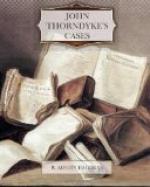This was the whole of Jezzard’s evidence, and was confirmed by that of Leach and Pitford. Then, when the fisherman had deposed to the discovery of the body, the sergeant was called, and stepped forward, grasping a carpet-bag, and looking as uncomfortable as if he had been the accused instead of a witness. He described the circumstances under which he saw the body, giving the exact time and place with official precision.
“You have heard Dr. Burrows’ description of the footprints?” the coroner inquired.
“Yes. There were two sets. One set were evidently made by deceased. They showed that he entered St. Bridget’s Bay from the direction of Port Marston. He had been walking along the shore just about high-water mark, sometimes above and sometimes below. Where he had walked below high-water mark the footprints had of course been washed away by the sea.”
“How far back did you trace the footprints of deceased?”
“About two-thirds of the way to Sundersley Gap. Then they disappeared below high-water mark. Later in the evening I walked from the Gap into Port Marston, but could not find any further traces of deceased. He must have walked between the tide-marks all the way from Port Marston to beyond Sundersley. When these footprints entered St. Bridget’s Bay they became mixed up with the footprints of another man, and the shore was trampled for a space of a dozen yards as if a furious struggle had taken place. The strange man’s tracks came down from the Shepherd’s Path, and went up it again; but, owing to the hardness of the ground from the dry weather, the tracks disappeared a short distance up the path, and I could not find them again.”
“What were these strange footprints like?” inquired the coroner.
“They were very peculiar,” replied the sergeant. “They were made by shoes armed with smallish hob-nails, which were arranged in a diamond-shaped pattern on the holes and in a cross on the heels. I measured the footprints carefully, and made a drawing of each foot at the time.” Here the sergeant produced a long notebook of funereal aspect, and, having opened it at a marked place, handed it to the coroner, who examined it attentively, and then passed it on to the jury. From the jury it was presently transferred to Thorndyke, and, looking over his shoulder, I saw a very workmanlike sketch of a pair of footprints with the principal dimensions inserted.
Thorndyke surveyed the drawing critically, jotted down a few brief notes, and returned the sergeant’s notebook to the coroner, who, as he took it, turned once more to the officer.
“Have you any clue, sergeant, to the person who made these footprints?” he asked.
By way of reply the sergeant opened his carpet-bag, and, extracting therefrom a pair of smart but stoutly made shoes, laid them on the table.
“Those shoes,” he said, “are the property of the accused; he was wearing them when I arrested him. They appear to correspond exactly to the footprints of the murderer. The measurements are the same, and the nails with which they are studded are arranged in a similar pattern.”




